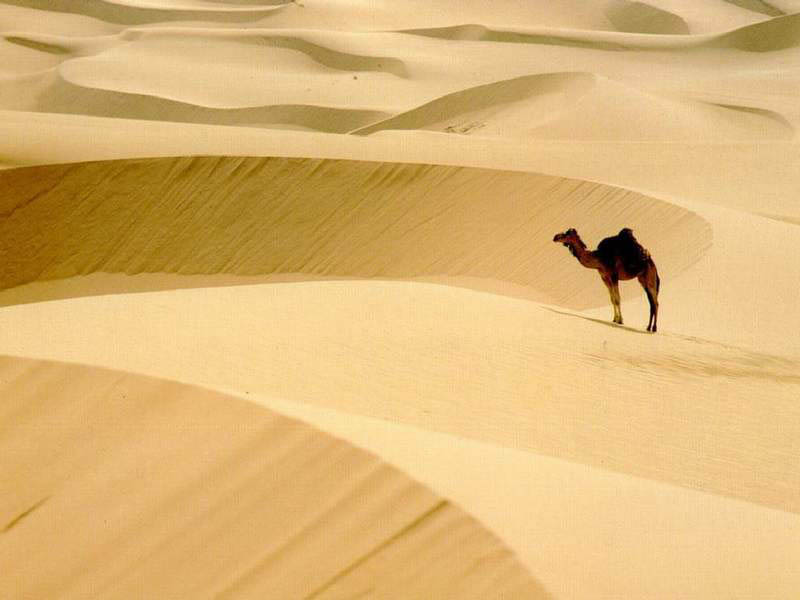 Sahara means sand dunes, infinity, nomads, oasis, camels, caravans, minerals, mirage…and dream. Dream is about the travellers before the immensity and also all those who imagine themselves having a trip throughout these grandiose and spectacular spaces. Going to the Sahara is making a great discovery and learning about life once more. It is the discovery of a land that is both hostile and welcoming, as well as grasping contradictory feelings. This ambivalence, in an alternating way, reveals endless instants of exaltation and long moments of torpor. The desert of the Sahara gives you monochrome even monotonous landscapes. Sometimes, they are wonderful, majestic and enchanting. As for the traveller, the panorama is as follows: the carnal sensuality of the sand dunes that have irresistible curves, the run up of ochre sandstone reliefs that merge on the horizon, the depth of the skies that equals the absolute, a sidereal silence that is more nourishing than words, the unspeakable tonality of a pearly dawn light or that of an indigo twilight.
Sahara means sand dunes, infinity, nomads, oasis, camels, caravans, minerals, mirage…and dream. Dream is about the travellers before the immensity and also all those who imagine themselves having a trip throughout these grandiose and spectacular spaces. Going to the Sahara is making a great discovery and learning about life once more. It is the discovery of a land that is both hostile and welcoming, as well as grasping contradictory feelings. This ambivalence, in an alternating way, reveals endless instants of exaltation and long moments of torpor. The desert of the Sahara gives you monochrome even monotonous landscapes. Sometimes, they are wonderful, majestic and enchanting. As for the traveller, the panorama is as follows: the carnal sensuality of the sand dunes that have irresistible curves, the run up of ochre sandstone reliefs that merge on the horizon, the depth of the skies that equals the absolute, a sidereal silence that is more nourishing than words, the unspeakable tonality of a pearly dawn light or that of an indigo twilight.
The Sahara covers large parts of Algeria, Chad, Egypt, Libya, Mali, Mauritania, Morocco, Niger, Western Sahara, Sudan and Tunisia. It is reputed to be the world’s biggest desert. Its boundaries are the Atlantic Ocean on the west, the Atlas Mountains and the Mediterranean Sea on the north, the Red Sea and Egypt on the east, and the Sudan and the valley of the Niger River on the south. It is divided into Western Sahara, the central Ahaggar Mountains, the Tibesti Mountains, the Air Mountains, the Ténéré desert, and the Libyan desert.
People lived on the edge of the desert thousands of years ago since the last ice age. It was then a much wetter place than it is today. Some 2.5 million people currently live in the Sahara, most of these in Egypt, Mauritania, Morocco and Algeria. Dominant ethnicities are Berber groups including Tuareg tribes, Arabised Berber groups such as the Hassaniya-speaking Moors (also known as Sahrawis), and black African peoples comprising Toubou, Nubians, Zaghawa, Kanuri, Peul or Fulani, Hausa and Songhai. Important cities located in the Sahara include Nouakchott in Mauritania, Faya-Largeau in Chad, Timbuktu in Mali, Agadez in Niger, Ghat in Libya, as well as Tamanrasset, Ouargla, Bechar, Hassi Messaoud, Ghardaia, and El Oued in Algeria.
In Tamadjert, a hidden valley in the rocky region of Ajjers in West Algeria, people use to have their business near the permanent watering place called Timba Oundi. That guelta or source feeds a series of basins that are positioned at intervals and lined with rosebays where a stream is dripping with cool and limpid water. Washing, ablution and water chore give rise to daily gossip between women whereas men are tending the flock around or gardening in the shade of the palm groves. The village comprises two rows of zeribas that are traditional houses with a stony circular foundation and a cone-shaped roof. In that landlocked area where hospitality is considered as a cardinal virtue people live thanks to market gardening and dates farming.
Camping has always been a rejoicing time for the traveller. Here in Tamadjert, being in connection with the camping site is considered as essential for a foreigner. Whether the bivouac is improvised in the hole of a sand dune, the shelter of a rock or under a Tuareg tent made of camel-hair coat, people have an equal respect for the place chosen. In a nomadic camping process, choosing the site depends mostly on the closeness to the pastures. For having a daylong travel in riding on a camel, on foot or by a cross-country car, camping becomes the symbol of hospitality. Here in the valley of Tamadjert, offering hospitality to someone is, first of all, sharing tea with him as well as pancakes. Nobody would fail to catch tea time in the Sahara. This tradition is veneration. Coming from Bamako, I went across the desert of the Sahara for two weeks, and the tea that I took in Tamadjert is my best “souvenir de voyage”. In this valley, people use to say: “Time, time… Take your time, and you will see that you cannot stop the course of events.”






